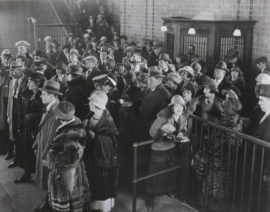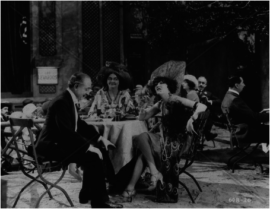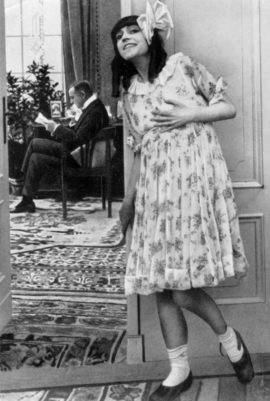Film historian and recent Academy Award winner Kevin Brownlow gave a very enjoyable talk yesterday about his meeting with a then 93-year old Allan Dwan for his 1980 documentary series Hollywood (watch the video of the talk here). While suffering from cataracts, Dwan proved as great and jovial a storyteller at the end of his life (he died in 1981) as he had been throughout his career as a filmmaker, upholding our idea of the great Irish directors – Ford, Walsh, Neilan, Wellman – as fabulists first: the stories they told about their life and work, Brownlow reminded us, should never be taken as historical fact, but as revealing their character and artistic temperament. Brownlow confessed that the silent film director is his favorite subject because these artists and professionals were honing their craft and tools as the industry was taking shape around them. It also helped that many of them, the Irish especially, were colorful roughneck characters. Dwan told Brownlow about the time an armed ‘detective’ hired by the Edison Trust came to see him when he was shooting his first films in California with unlicensed equipment. To make his case the patents agent fired his gun at a row of cans but missed, whereupon Dwan drew his, fired, and hit three in a row. The patents man was subsequently railroaded out of town by ranch hands working on the Flying A Westerns. This was outlaw filmmaking, and Dwan sourly recalled the moment when producers came to rule the industry. In another memorable tall tale he recalled the time he threw a producer who had criticized his dailies – one of those ‘relatives’ of the company boss – over a wall between two sets. The director filming next door, Robert Leonard, didn’t want him either and threw him right back. Dwan was a true independent, a free spirit, who did his best work for companies, like Paramount and United Artists in the twenties, that left their directors alone (his films for Fox, the studio where he worked the longest alongside Walsh and Ford, are his most anonymous, programmers mostly that lack the energy and pace of his best work). He was always a strong presence on set, exuding know-how and confidence. When Doug Fairbanks walked off Robin Hood because he feared his natural charisma would be dwarfed by the gigantic sets, Dwan built slides and designed set pieces to show off the actor’s physical skill and grace, setting the template that would make Doug the biggest star in pictures.

Sometimes working with great stars was all about convincing, and Dwan was a great persuader. He convinced Gloria Swanson to work (in disguise) as a salesgirl at a big department store to soak up atmosphere for her role in the comedy Manhandled(1924). He also persuaded her to take a ride on the New York subway, something she had never done before since she was in the habit of being chauffeured around in limos. The results of that experiment were put to good use in the funniest scene in Manhandled, with Gloria being squished, lifted and, well, manhandled by a vast mass of New York city commuters in a realistic set built in Paramount’s Astoria studios. As Brownlow notes, that scene inspired similar ones in movies like Speedy, Subway Sadie and Rush Hour. Dwan was regularly working out of New York at the time, a city whose mythic allure and colorful neighborhood life he managed to capture with almost novelistic detail in East Side, West Side (1927), a picture that is quite wonderful in its first reels but is then let down by a by-the-numbers melodramatic plot and Fox’s ambition to pump up its scope by including a spectacular shipwreck loosely based on the Titanic (the movie was actually re-titled Titanic for its German release).

At Paramount, Dwan was also regularly working with Swanson, who had tired of the ‘clotheshorse’ parts in the DeMille pictures and wanted to try character roles with more meat on them. The first of these was Zaza (1923), based on the play by Pierre Berton and Charles Simon, the story of a small-town entertainer who falls for one of her admirers. Zaza was a role that had brought fame to Gabrielle Réjeane, Sarah Bernhardt and, in the Belasco version, Leslie Carter, as the opening titles remind us. Zaza was updated from the 1890s to the period just before the First World War and adapted to fit Gloria Swanson’s persona, turning the title character in a feisty gamine in the Mary Pickford mode. At one point in the story, Zaza tears the clothes of the back of her rival when she learns that her beau is married, an epic catfight done in one take because there were no duplicate costumes. Swanson tears into the role with great gusto and energy, at the same time knowingly underplaying the quieter moments. It is perhaps her freshest, most entertaining performance in silents, worlds apart from the histrionic posing of Queen Kelly or Sunset Boulevard. The cast of Zaza is uniformly terrific; as Bernard Dufresne, H.B. Warner exhibits the kind of dignity, likeability and, in the final scenes, gravitas that would serve him so well in DeMille’s King of Kings, while both Lucille La Verne and Mary Thurman (who died of pneumonia shortly after the movie was released) are a riot as, respectively, Zaza’s dipsomaniac aunt and rival. The French setting, the theme of self-sacrifice, and the overall class of the production bring to mind George Cukor’s Camille, and it’s no coincidence that Cukor made his own version of Zaza in 1939, starring Claudette Colbert and Herbert Marshall. Like Cukor, Dwan is highly adept at mixing the serious and the funny, never losing that lightness of touch, which he convinced Doug Fairbanks was key to all great artistry.
That both Manhandled and Zaza are such fresh, lively entertainments can be credited both to Swanson’s confident star performances, the witty scripts (Manhandled was written by comedy director Frank Tuttle), and Dwan’s direction always fitting the subject: where most of the scenes in Manhandled are framed in medium shots or medium close-ups, befitting that story’s smaller scale, Zaza shows Dwan’s considerable talent for group framings. The frame in Zaza bustles with activity, crowded with extras and background figures that are never just standing around but are always in the story, given little bits of business that motivate movement or small gestures. Also, these are some of the best edited movies you are likely to find in the silent period, Dwan allowing for extra crisp eyeline cuts and matches on action, varying camera angles to bring the viewer into the story, never just to show off the impressive set design. If these movies are a ‘feather in the cap’ of Dwan, as Motion Picture Magazine noted, then they are also a tribute to one of the great unsung heroes of the silent and classical era, cinematographer Hal Rosson, who brings to Dwan’s storytelling skills a subtle pictorialism that never draws attention to itself. The Rosson-Dwan collaboration is firing on all cylinders in Zaza’s unforgettably eloquent final shot, in which the two lovers, who have met again after the War when much of their old lives and selves has been destroyed, seem to fade into eternity, as in an Ophüls movie.

Manhandled is the type of picture that was quite typical of the period: the light morality tale about upward mobility, specifically the young working-class women that were flooding the job market at the end of the teens-beginning of the twenties, and the anxiety this caused for conservative editorialists and patriarchy in general. These comedies generally featured flapper girls like Clara Bow (the original flapper girl, Olive Thomas, actually worked as a wrapper at a department store). A real surprise of the period was that Mary Pickford, whose star persona was geared more to Victorian-sentimental values, adapted the flapper persona and eventually even a bobbed hairdo in My Best Girl (1927) in which she plays a stock girl at a department store. I was reminded of Pickford in Swanson’s physical comedy, comic dancing and tantrum-throwing in the two Dwan films. Such are the joys of the Cinema Ritrovato that, upon stepping out of Manhandled, I ended up in another screening that again brought to mind the girl with the curls. Urban Gad’s Engelein (1914) offers an unusual part for Asta Nielsen, the ‘first international movie star’ who had followed Gad from Denmark to Germany, where she was given her own studio. In this farcical comedy Asta plays seventeen-year old Jesta who is posing as a twelve-year old to trick her father’s brother, a rich childless widower from Chicago, into believing she was born shortly after her mother and father were married, instead of five years earlier, and can therefore be his rightful heir. Nielsen was 32 when she played Jesta; Pickford was ‘only’ 25 when she played her first child role in a feature in Poor Little Rich Girl (1917), and, at times, Nielsen’s supple, pouty performance seems like a rough draft for one of Pickford’s most defining roles. The difference of course is that Nielsen is ostensively playing at being a child, and the comedy of Engelein derives in large part from the unlikelihood of anyone mistaking Asta for twelve, or seventeen for that matter. Anke Brouwers, who’s worked extensively on Pickford (see here), reminded me that the romance part was always the most uncomfortable part of the star’s juvenile roles: genre and the fact that these were star vehicles demanded a romance, and although the male leads were often written as young as Pickford, in many cases, as in Daddy-Long-Legs or Polyanna, they were much older. While the age of the child character is never reiterated when the romance part is in full bloom in the Pickford films, in Engelein it is milked for full comedic value: ‘But you’re just a child!’ Uncle Peter declares when Jesta, who has fallen in love with him, asks for a kiss that is not ‘the kind of dry uncle-kiss.’
As was to be expected, the movie got into trouble with the censors over its May-December fondling (Max Landa, who plays uncle Peter, was forty at the time). Although targeted, at least in part, at a young audience, the censor did not allow anyone under 20 to see it. In his chapter on early German comedies in Thomas Elsaesser’s essential collection, A Second Life: German Cinema’s First Decades, Thomas Brandlmeier ranks the Asta Nielsen films with a number of non-conformist comedies of the period that actually take the censor’s concern for public morality as their subject. Cross-dressing and masquerade were amongst the favored burlesque techniques of these Lustspiele or farces. The character of Jesta was based on Asta Nielsen’s daughter, also named Jesta, who was born out of wedlock. But the plot, with a scheming couple dressing up their daughter to get their hands on a rich uncle’s inheritance, is pure farce. I finished my day at the Cinema Ritrovato with Dwan’s Up in Mabel’s Room (1944), one of the most popular American farces, written by Wilson Collison and Otto Harbach, that was frequently adapted for the cinema. Since our Dwan program also includes his 1919 Getting Mary Married, written by Anita Loos and John Emerson, I will be digging deeper into the legacy of farce in American comedy, both in the silent period and in the movies Dwan made for independent producer Edward Small during the War years.